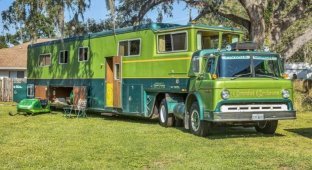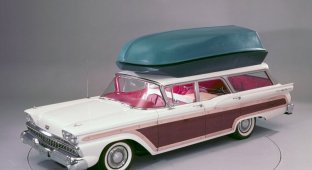The first "Washington" heavy cruisers of Italy. History of Trento and Trieste (18 photos)
After the end of the First World War and the collapse of the Austro-Hungarian Empire, France remained the only potential enemy for the Kingdom of Italy in the Mediterranean region. The balance of naval forces of the two countries was clearly not in favor of Regia Marina. 
Trento-class heavy cruiser Trieste, 1929
If there was at least approximate parity in battleships, then in cruisers the Italian fleet was in a deplorable situation. The only modern ships of this type were three light cruisers received as reparations from Germany.
After the signing of the Washington Naval Agreement, France laid down two new Duquesne-class heavy cruisers and three Duguay Treville-class light cruisers. Taking this into account, Supermarina issued an order to develop a project for its own “Washington” cruiser with a displacement of up to 10,000 tons, armed with 8-inch guns and a speed of 35 knots. Even before the creation of the project, the construction of two such cruisers was included in the shipbuilding program approved for 1923.
The project was developed by the Warship Project Committee of the Ministry of the Navy at the beginning of 1924. Already in the first half of the next year, the hulls of the cruisers Trento and Trieste were laid down at the shipyards in Livorno and Trieste.
Firstborns of Regia Marina
Despite all the efforts of the designers, the standard displacement of the new ships exceeded the contractual limits by 500 tons and amounted to almost 10,500 tons, and the total displacement reached almost 13,500 tons.
The smooth-deck hull, 196.5 m long at the waterline and 20 m wide at the bow, had a slight rise to the stem to improve seaworthiness. The hull's power set scheme was mixed. From the keel to the base of the main armor belt, a set was used in a longitudinal pattern, which made it possible to create an effective and durable double bottom structure. The part of the hull between the main armored belt and the armored deck (main deck) was assembled according to a transverse pattern, and from the main to the upper deck a longitudinal pattern was again used. 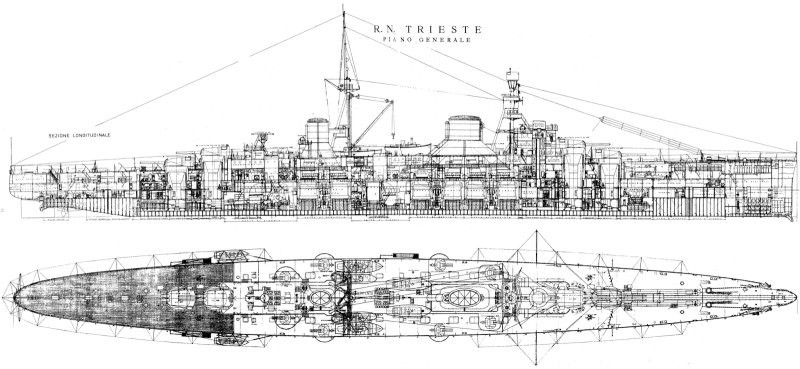
Copy of an original drawing of the Trento-class heavy cruiser Trieste
To provide the cruiser with high speed, the hull had very sharp contours and a large length-to-width ratio. This led to the fact that during full stroke, strong vibration of the hull began, although to reduce wave resistance, a bulb was installed in the bow for the first time in Italian shipbuilding.
The poorly developed three-tier forward superstructure with a conning tower also carried a foremast. Due to strong vibration, the foremast, which was originally three-legged, had to be strengthened in 1929 with two additional supports.
"Elegant" protection
When developing armor protection for Trento-class cruisers, the main requirement was the ability to withstand guns up to 155 mm caliber - the main armament of French and British light cruisers. 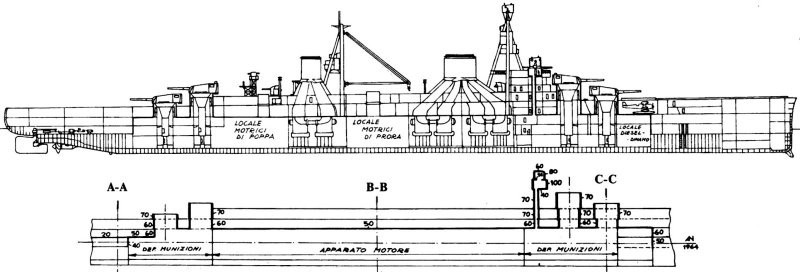
Armor scheme for the heavy cruiser Trento
Therefore, for the main armor belt, plates of 70-mm homogeneous chromium-nickel armor were used, installed overlapping in two rows. The belt extended along the entire length of the citadel, protruding 8 meters beyond the bow tower of the main battery and 5 meters beyond the stern one. The cross beams were 60 mm thick at the top and 50 mm at the bottom.
The main armored deck, 50 mm thick, had a slightly convex design and rested on the main armored belt. The superstructures had no armor. Only the conning tower was protected on the sides and front by 100 mm armor. 
Cross section of the heavy cruiser Trieste
The main caliber turrets were protected by 100 mm of armor in the frontal projection. A special feature was the elongated barbettes, which reached to the second bottom and provided higher protection of the cellars from hits from enemy shells and possible fires.
For the first time in the Italian fleet, a very powerful and modern four-shaft power plant with a total power of 150,000 hp was installed on cruisers. For comparison, the battleships of the Conte di Cavour class, which had twice the displacement, had a power plant of 31,500 hp. 
A copy of the original drawing. Diagram of the power plant of the heavy cruiser Trieste
During sea trials, Trento-class cruisers were able to reach speeds of more than 35.5 knots. ButDuring operation, it turned out that long running even at 30 knots leads to increased wear of the machines and their failure.
"Two Eights"
Like all “Washington” cruisers, “Trento” and “Trieste” received 8-inch guns—the maximum allowed under the treaty. Each cruiser carried 8 guns in two-gun turrets arranged in a linearly elevated pattern. The towers had a firing angle of 300 degrees. At a maximum elevation angle of 45°, the firing range reached 31 km. 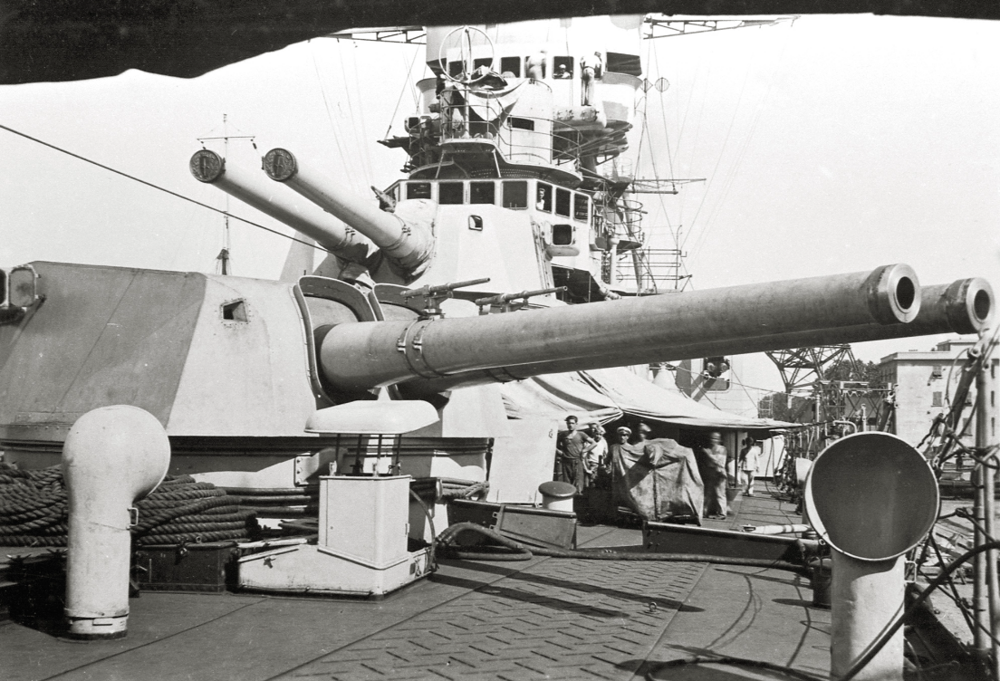
203-mm Ansaldo Model 1924 main caliber turret on the cruiser Trieste
To achieve weight savings, the designers placed both guns in the turret in one cradle. The joint arrangement of the guns made it possible to reduce the weight of the turret installation, but this solution led to a number of problems. Due to the small distance between the axes of the gun barrels, the accuracy and accuracy of fire decreased significantly, and the wear of the barrels also increased. If the cradle mechanism or one of the barrels failed, for example as a result of a hit, the entire turret installation would fail.
Armor-piercing shells weighing 125 kg and high-explosive shells weighing 110 kg were used for firing. Both projectiles had high speeds (905 and 940 m/s, respectively), which led to even more wear on the barrel. Therefore, later lighter projectiles were used for firing with a speed of 840 m/s and an achieved firing range of 28 km.
Since the number of main battery guns was limited by the Washington Agreements, Italian designers decided to increase the firepower of their cruisers by strengthening auxiliary artillery. For such ships, the standard was to have six to eight mine-caliber guns. But on the Trento-class cruisers, the project included eight twin mounts of 100 mm guns. And to protect against aviation, four 40-mm anti-aircraft guns were installed on each ship in the central part. 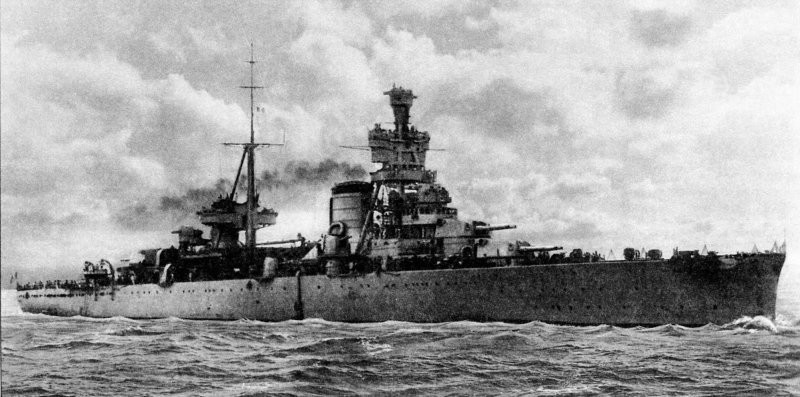
Cruiser Trento after modernization in 1931
The torpedo tubes were not rotating. The torpedoes were launched through special holes in the side, where the torpedoes were transported along rails. Therefore, only one device from a pair could fire at a time from each side.
For the first time in the Italian fleet, Trento-class cruisers received aviation weapons - 3 float biplanes. To launch them, a steam catapult of the Gagnotto system was mounted in the bow of the cruiser in front of the main caliber guns, which accelerated the aircraft to 113 km/h. Since there were no booms for lifting the seaplane on board, according to the instructions, after completing the task it had to return to the coastal airfield. Later, the cruisers were re-equipped with two flying boats with folding wings, and in 1938 they were replaced by biplane seaplanes, standard for the Italian fleet until the end of World War II. 
Seaplane Ro. 43 on the catapult of the cruiser Trento, February 21, 1942
In the war of convoys
After its entry into service on April 3, 1929, Trento, together with Trieste, which entered service earlier, became a symbol of the power of fascist Italy. Ships regularly displayed the Italian flag not only in Mediterranean ports, but throughout the world. In the spring of 1932, the cruiser Trento spent more than 2 months in China, representing the Italian Navy in the region. 
Italian heavy cruisers in the Gaetta roadstead, 1933
In 1933, all heavy cruisers, including the Bolzano that entered service, were reduced to two divisions. Trento became the flagship of the 2nd Division, which included Trieste and Bolzano. Until 1939, he regularly went on foreign campaigns and also took part in exercises. 
Heavy cruiser Trento in Taranto, 1936
After entering World War II on June 10, 1940, Italy reorganized its navy. After her, the cruiser Trento became the flagship of the 3rd Division as part of the 2nd Squadron of Rear Admiral Carlo Cattaneo, which was assigned reconnaissance missions. 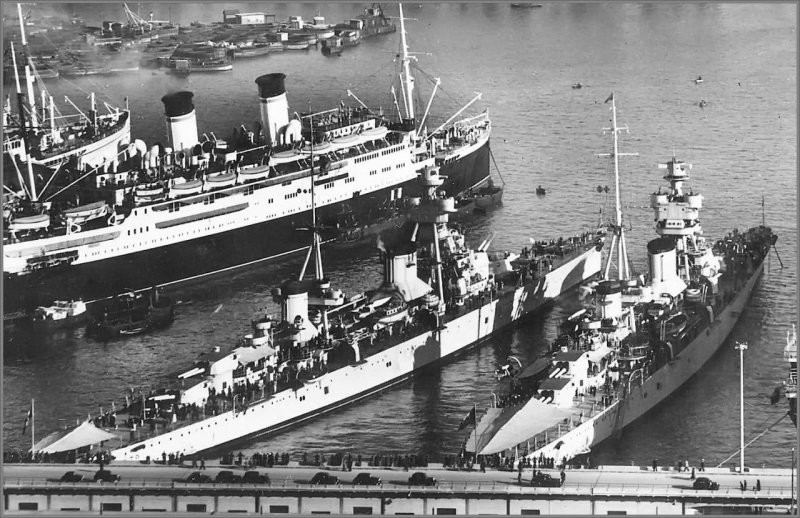
Heavy cruisers Trento and Trieste in Genoa shortly before the outbreak of World War II, May 1938
On June 10, the ships of the 3rd squadron set out on their first combat mission to cover the operation to lay a minefield near the island of Lampedusa. By evening intelligence information was receivedabout the presence of British light cruisers in their area. The squadron was sent to intercept them, but failed to detect the enemy.
On July 9, 1940, Trento, as part of a large formation of the Italian fleet, took part in the battle of Punto Stilo with ships of the British Mediterranean Fleet. Together with the cruisers of the 1st Division and the ships of Admiral Palladini, he covered the vanguard of the formation and engaged the British light cruisers of Force A under the command of Vice Admiral Tovey. 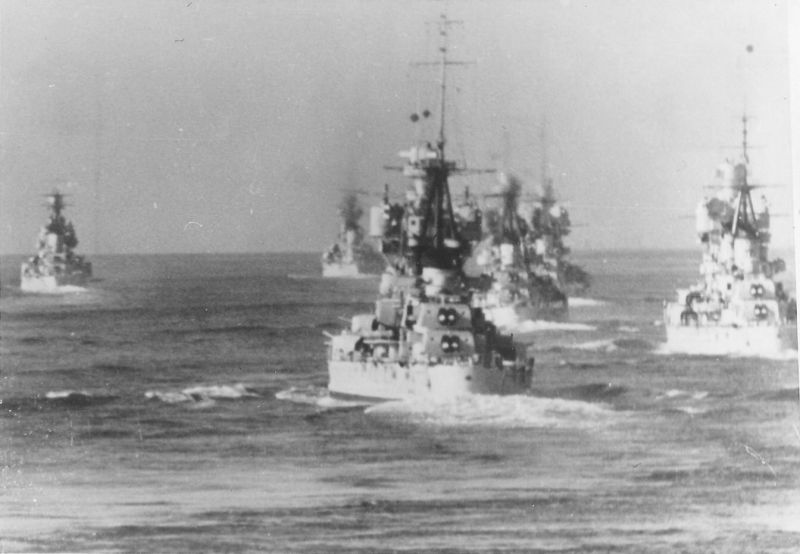
Italian heavy cruisers the day before the battle of Punto Stilo. From left to right the cruisers Bolzano, Trento, Fiume, Zara, Pola and Gorizia are visible
The shooting took place at a distance of 11 miles. Neither side caused serious harm to its opponents. At 15:45, the Trento anti-aircraft gunners successfully repelled an air attack by torpedo bombers from the Eagle aircraft carrier, but by 16:05 the situation on the battlefield had changed dramatically. Before this, the Trento and other Italian ships fought an artillery duel with light cruisers armed with 6-inch guns. But after Conte di Cavour and Giulio Cesare withdrew from the battle, the British battleships shifted their 15-inch guns to the cruisers. This forced the Italians to stop firing and withdraw from the battle under the cover of a smoke screen from destroyers. 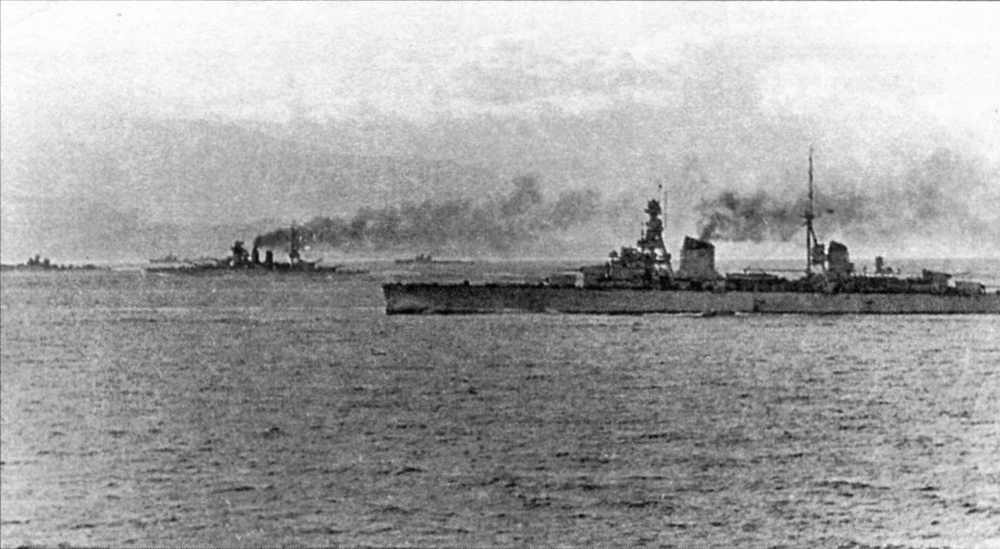
The Italian fleet departs to the shores of Calabria on the evening of July 9, 1940. In the foreground is Trento, behind him is Giulio Cesare.
Until October 21, 1940, Trento-class cruisers were involved several times in convoy operations and reconnaissance in the Aegean Sea, Malta and Crete, after which they were relocated to Taranto. During a British air raid on Taranto, the Trento was hit by a 250 pound semi-armor-piercing bomb, which penetrated the armored deck. The cruiser was saved from serious damage only by the fact that the bomb did not explode, being stuck in one of the technical rooms under the main deck. 
Heavy cruiser Trento in war paint
On November 27, 1940, Trento, together with the ships of the 1st and 2nd squadrons, took part in the battle off Cape Teulada. Due to a mistake by the squadron commander, Admiral Campioni, the heavy cruisers in the vanguard were forced to engage in battle with the British light cruisers, which were joined after some time by the battleship Ramilies and the battlecruiser Rhinaun. Only thanks to their superior speed did the Italian ships leave the battle and manage to escape from the enemy.
Until the beginning of March, Trento again participated in convoy and patrol operations, and several times went out to intercept British convoys, but to no avail. On March 26, 1941, during Operation Gaudo, the 1st, 3rd and 8th cruiser divisions, with the support of the battleship Vittorio Veneto, moved to Crete to intercept the British convoy. On the morning of March 28, British cruisers of Force B were spotted off the island of Gavdos. 
Camouflage scheme for the heavy cruiser Trento at the end of 1941
Due to poor visibility and outdated fire control systems, the Italian gunners were unable to score hits and exploit their advantage in firepower. During the air attack at approximately 16:00, Trento received minor damage from close explosions, but retained its speed, speed and combat qualities.
From May to August 1941, the cruiser was undergoing scheduled repairs. On November 8, 1941, she provided cover for the notorious Beta convoy and, during a night battle with British cruisers, only miraculously dodged three torpedoes fired by the Upholder submarine. In November 1941, Trento took part in the first battle in the Gulf of Sirte, and in the spring of 1942 - in the second battle in the Gulf of Sirte. 
Heavy cruiser Trento at the head of the 3rd cruiser division
On June 14, 1942, Trento, as part of Admiral Iachino’s squadron, set out to intercept a British convoy leaving Alexandria. After the squadron was discovered, on June 15 the ships were attacked by British aircraft, which carried out two air raids at 02:30 and 05:00.
During the attack of the second wave at 05:15, a torpedo from the torpedo bomber Bristol Beaufort hit the Trento in the area of the bow boilers. Water poured into the hole, flooding both bow boiler rooms and the engine room and causing a fire. The fire quickly spread and brought cars to a complete stop. The emergency team managed to apply a patch and stop the leak. But the fire could not be put out quickly. The fire spread further and further throughout the shipYu. The fight against the fire continued until 8 am. By this time, the rescuers managed to extinguish the fire, and the mechanics restored the operation of the stern engines and reported that they could give the ship movement. 
Heavy cruiser Trento in camouflage, 1942
At 09:00, the destroyer Antonio Pigafetta began preparations for towing. But literally 10 minutes later, a powerful explosion was heard on the left side in the area of the second bow tower. According to British Admiralty documents, it was a torpedo fired by the British submarine P35. The fact of the hit was confirmed by the crew of the P34 submarine, which was nearby. The torpedo caused the detonation of shells in the artillery magazine. The cruiser received a strong trim on the bow and began to rapidly sink. At 09:14 he went under water. Of the 1,150 crew members, only 600 were saved.
In theory and practice
In general, Trento and Trieste were typical representatives of the early Washington cruisers. They differed from their classmates from other countries in their relatively high speed and relatively powerful armor, which provided protection from 6-inch shells. At the same time, they carried 203 mm guns.
But it was precisely these guns and imperfect fire control systems that became the weak point of the Trento-class cruisers, and indeed all other Italian cruisers. Excessively forced ballistics and the desire to make the turret installation as light as possible led to a deterioration in accuracy and accuracy. In the battles in which the Trento took part, more than 5,000 shells were fired from its main caliber guns, but the gunners were unable to achieve a single hit on the enemy. So, although these cruisers looked formidable on paper, in reality their strength in a naval battle could not be confirmed.













